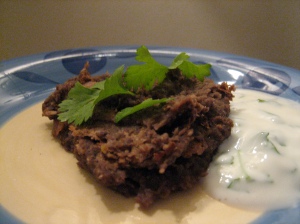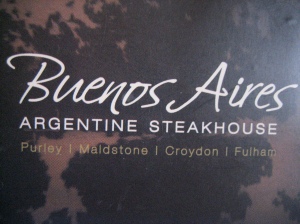Cooked Thursday 23 June 2011
Caribbean restaurants are tricky because they are usually just “Caribbean”, without specifying the island(s). So again, we did it ourselves, this time at Sophie’s family home in Woking. Sophie’s starter was brown and lumpy; Joe’s main involved the dreaded pigeon peas; Steve’s dessert was a disgrace of which more will be told soon.
You would think that finding Caribbean cuisine in London would be a synch. And you would be right. But finding a restaurant that specifically cooks food from Antigua and Barbuda is another matter. As you would expect, dear reader, we did our very best to overcome the odds, making desperate phone calls to a wide variety of Caribbean restaurants and asking their confused owners and chefs for their ethnic origin. We hit a brick wall and so Antigua like Angola before it was fated to be a do-it-yourself feast.
The Writer was in charge of the main course on this occasion and his list of ingredients for Pepperpot Stew filled me with dread. Top offender was corned beef. Now, now, I hear you saying, it could be worse, it could be Spam. And yes, you would have a point, it could be Spam but actually nothing fills me with more horror and revulsion than the red, gravel patterned, glistening lump of rectangular flesh that is corned beef, squelching from the can with a wet, mocking, flump. My aversion to corned beef has its roots in the days of school dinners when corned beef fritters were a weekly feature on our canteen blackboard. Bearing in mind I went to an army school in Germany, those were the days when there was no such thing as choice (I don’t think they even had a vegetarian option), you just got whatever they had cooked and quite often that was corned beef fritters. We also had a dictatorial table system – each child was assigned a table according to their age, two of each year group at each table. The tables were lined up in Oliver Twist style rows complete with a year 6 ‘server’ at the head of each table, dishing up the sauerkraut and flaccid grey broccoli. Their job was to see that every last mouthful was eaten by all the children on their table, and if it wasn’t, there was NO PUDDING.
You can imagine then, my hatred of corned beef fritters. As a child who adored puddings there was no other solution than to force every last gobbet of oily, fetid meat down my unwilling gullet. Corned beef fritters are a catch-22. You can either eat them straight away whilst the oil from the batter is still hot enough to burn your tongue and the meat within adheres to the roof of your mouth, or you can wait until they are cold, when the slimy, rubbery rectangle of meat has come away from the greasy wet cardboard of the batter so that if you cut off one end of the batter and tipped the casing upside down the meat would slip out and land with a belly flop on your plate. There is no in between. Now you understand why I hate corned beef.
There were other undesirable ingredients in the Pepperpot Stew, including pigeon peas, a variety of split pea which came in a tin from Atif’s (our local Asian supermarket), grey in colour and smelling like a mixture of clay and vomit, their appearance was not dissimilar to the mushy peas that sometimes accompanied corned beef fritters. Nevertheless, the stew proved to be surprisingly tasty. Once past the faint permeating taste of corned beef which had disintegrated, thereby infiltrating the entire pot, the chunks of pork belly, squash and yam were filling and tasty whilst the sauce was infused with the warmth of scotch bonnet chilli. Whilst Pepperpot can be found throughout the Caribbean the addition of spinach is apparently what makes it uniquely Antiguan.
The black bean cake starter and the pineapple and cherry trifle dessert were cooked by myself and Steve respectively and were both culinary disasters but both extremely delicious. I have included the recipes for both with the adaptations required to (hopefully) rectify the problems. Mine was a disaster because the black bean cakes refused to stick together and so ended up as half-cooked blobs that can only be described as looking like dog turds. Steve’s was a disaster because it involved eight raw eggs which at no point did the recipe require you to cook. Terrified by the thought of poisoning us all he cooked it in the oven, turning it into something resembling bread-and-butter pudding, I think this was actually a culinary triumph against all the odds. I had seconds.
After our three course dinner I discovered that the rum in the liquor cabinet had mysteriously evaporated so we were left to find the next best thing – Tia Maria, which claims to be from Jamaica, and which was bought at the NAAFI store in Germany around the same time as I was being served up corned beef fritters with mushy peas. It’s potent stuff.
Black Bean Cakes

So yer… well it tasted alright
Ingredients
2 cups cooked black beans, ½ cup finely chopped onion, 1 ½ teaspoons ground cumin, 1 tablespoon finely chopped jalapeno chilli, cornstarch, and 2 tablespoons olive oil.
Method
Use a food processor to prepare the black beans, onion, cumin, and jalapeno, pulsing them until smooth. Then add 1 tablespoon of water to help blend. Use salt and pepper to taste. Next, shape the bean paste into small cakes using 2 tablespoons of bean mixture for each. Then, line a baking sheet with plastic wrap and dust with cornstarch to prevent the mixture from sticking.
Now, heat a small amount of oil in a large frying pan before adding the black bean cakes. Cook the cakes to a crispy brown (about 3 minutes per side), then transfer to platter and keep warm.
I suspect that my mixture failed to form into neat cakes due to too much water – this is probably because I used canned black beans. If you are also using canned I suggest leaving out the tbsp of water.
Pepperpot Stew with Fungee

The grey blobs are pigeon peas *shudder*
Ingredients for Pepperpot Stew
1 tin pigeon peas
300g corned beef, cut into 1-inch pieces
500g belly pork
2 tins water
1 large onion, chopped
4 spring onions, chopped
3 garlic cloves, minced
1 fresh Scotch bonnet chili, seeded and minced
1 can chopped tomatoes
1/4 cup tomato paste
1 tbsp chopped fresh chives
1/2 tsp dried thyme
1 medium aubergine, cut into 1-inch pieces
Half butternut squash (instead of calabaza) cut into 1-inch pieces
230g white yam, peeled and cut into 1-inch pieces
115g fresh spinach, stemmed, well washed, and coarsely chopped
black pepper to taste.
Method
In a casserole dish, bring the corned beef, pork, and water to a boil. Reduce the heat to low, and simmer for 1 1/2 hours or until the meat is tender. Drain the meat, reserving both the meat and the cooking liquid. Heat the oil in the dish over medium heat. Add the onion, spring onions, garlic, and chilli pepper. Cook, stirring often, until the onion has softened. Stir in the tomatoes, tomato paste, chives, and thyme. Bring to a boil, reduce the heat to low, and simmer for 10 minutes. Stir in the aubergine, squash, and white yam and cook for 5 minutes, stirring often. Stir in the reserved cooking liquid and the meat. Bring to a boil, reduce the heat to low, and simmer for 20 minutes, stirring often, until the vegetables are tender. Stir in the cooked pigeon peas and the spinach, and cook for about 5 minutes until the spinach has wilted. Season with the pepper to taste depending on the hotness of the chilli.
The Writer just ignored all of the directions and made a big stew, cooking for 2 hours and then reducing slightly before serving.
Ingredients for Fungee
4 cups water
2 cups corn meal
1 tsp salt to taste
6 okra, cut into small pieces
Method
Place water, okra and salt in a pan. Bring to the boil until the okra are cooked. Remove half the liquid. Stir with a wooden spoon. Add enough cold water to the corn meal to form a pasty batter when mixed. Add the wet corn meal to the okra. Reduce the heat and stir continuously with a wooden spoon until the mixture becomes fairly stiff. When the mixture breaks away cleanly from the pan (i.e it does not stick), the fungee is ready. Butter a bowl, turn the mixture into the bowl, shaking it into the shape of the bowl, then turn it out into a serving dish.
Pineapple and Cherry Trifle/Bread-and-Butter Pudding
Ingredients

Better known as bread-and-butter pudding
2 cups butter
2 cups sugar
1 Pan levi (Angolan cake)
2 medium can of crushed pineapple
1 small jar of cherry
8 eggs
Rum
Vanilla essence
Method
Beat the butter until creamy before adding the sugar a little at a time. Drain the pineapple and cherries and separate the eggs. Reserve the pineapple and cherry juice for later use. Add the pineapple, sliced cherries and egg yolks to the butter and sugar and incorporate. Beat the egg whites well until they thicken and add this to the mixture as well.
Make a syrup with the pineapple and cherry juice, some vanilla and rum. Slices the pan levi into three layers and moisten with the syrup. Spread some of the creamy fruit mixture onto the first layer of the pan levi and sprinkle some syrup over the top. Close with the second layer and repeat. On the top of the cake spread the rest of the cream and syrup. Garnish with pineapple and cherry.
If, like Steve, you are concerned about the quantity of raw eggs in this, pop it into the oven for 20 minutes at 200C and you’ll create something not unlike bread-and-butter pudding.
Scores
Food: 2/5














